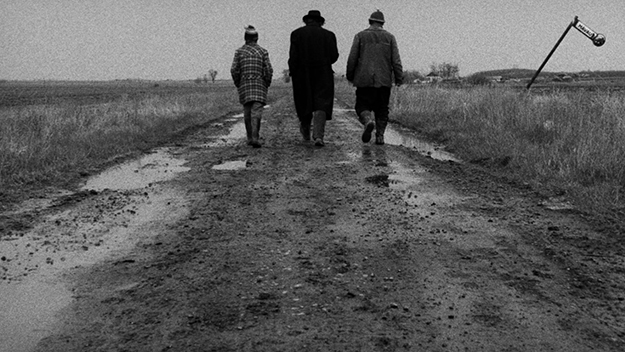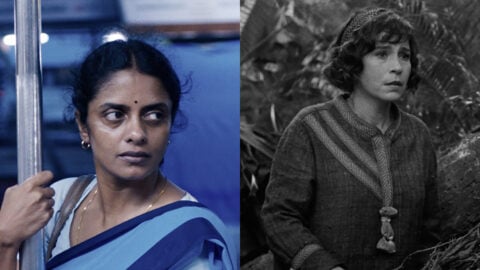News to Me: Robert Eggers, Béla Tarr, and evil movies

1) To mark the film’s 25th anniversary, Béla Tarr’s 7-hour masterpiece Sátántangó has received a brand new 4K restoration, playing at Film at Lincoln Center this week only. Tarr recently sat down with MUBI Notebook to discuss the film, stating: “I spent two years in the Hungarian lowlands filming, I can tell you I know all the houses, I know all the fucking roads, I know everything in this part of the country . . . and of course, we did not have a script, we had only the novel and my vision. That’s all we had.” (For more on Tarr’s ever-grim oeuvre, check out this 2006 interview with BOMB.)
2) With Robert Eggers’s The Lighthouse hitting cinemas just last week, the director is already eyeing his next project: titled The Northman, the film is “set in Iceland at the turn of the 10th century” and “centers around a Nordic prince who sets out on a mission of revenge after his father is murdered,” according to IndieWire. The cast currently includes Lighthouse returnee Willem Defoe, as well as Nicole Kidman, Bill Skarsgård, and Anya Taylor-Joy. We recently hosted Eggers for a Film at Lincoln Center Free Talk (going live on the podcast later this week), but for more on the film, check out Nick Pinkerton’s description of “Winslow having to huff his roommates’ rancid farts” over at Artforum.
3) More in the way of casting news: David Fincher’s forthcoming Mank (noted a few weeks back) has found its Orson Welles, with Tom Burke of The Souvenir winning the role. Also in the lineup, Amanda Seyfried as broadway star Marion Davies (who later became newspaper tycoon William Randolph Hearst’s wife and managerial pet-project), as well as Charles Dance, Lily Collins, and Tom Pelphrey. Mindhunter cinematographer Erik Messerschmidt will shoot the film.
4) For The Paris Review, Lucy Scholes writes on the literary career of Emeric Pressburger— focusing on the autobiographical details of his underappreciated novel, The Glass Pearls: “The whole novel is something of an extended chase sequence in the same vein as Powell and Pressburger’s brilliant film 49th Parallel.” On the other side of the ampersand: for our May-June 2005 issue, Richard Combs penned this piece on the life of Michael Powell—“what was also English in Powell was an imperial pulse, and there were fervid dreams at the end of the Forties of establishing a base—a solipsistic or national one—to rival Hollywood.”
5) Kinoscope currently has a Dan Sallitt retrospective underway, with Honeymoon, All the Ships At Sea, and Polly Perverse Strikes Again! available for viewing. With the release of his feature Fourteen this year, and his short Caterina premiering at NYFF57, Sallitt sat down with Kinoscope to discuss his career at length. Speaking on Polly Perverse: “I was fairly arrogant about the cinema at that point in my life, as is painfully obvious from my film criticism of the time. It’s not so bad for an artist to encourage his or her arrogance.” And for a double-bill of long-form Sallitt interviews, check out this piece from the Seattle Screen Scene.
6) Two upcoming collections are worth your attention: the first, Musings, Volume I & II, from Oscilloscope Laboratories, an anthology “full of insight and scholarship, ranging from pocket histories to artist profiles to deep dives into particular films.” Some names scattered between the two issues: April Wolfe, K. Austin Collins, Noel Murray, Alissa Wilkinson, Sheila O’Malley, and many more. And the second, the complete and collected editions of Art-Rite, an “underground/overground” periodical from the streets of New York City in the ’70s, featuring such artists as Carolee Schneeman, Jack Smith, and Patti Smith.
7) Yet another reminder of the imminent escalation in streaming warfare: the forthcoming WarnerMedia channel HBO Max has just snapped up the rights to all 21 Studio Ghibli films. Expected to launch in the spring of 2020, HBO Max has been quietly collecting coveted television for a while now—including Friends, The Big Bang Theory, and The Office (UK)—but the Ghibli grab marks its first real foray into sought-after cinema. Major competitors Disney+ and Apple TV+ are set to launch in November this year. (For more on the likes of Princess Mononoke, Kiki’s Delivery Service, and My Neighbour Totoro, check out David Chute’s piece from our Nov-Dec 1998 issue on “The World of Hayao Miyazaki.”)
8) Marriage Story is set to re-open the (only recently) closed doors of Manhattan’s Paris Theatre, with the Netflix film playing in limited release from November 6 (opening wider a week later, and then available to stream on December 6). The single-screen movie house had notably stalled earlier this year, stuck screening Ron Howard’s Pavarotti for months until the bad news finally broke. According to Deadline, Netflix is playing coy about the prospect of properly rescuing the theater, but may use it again for future premieres. The Marriage Story move follows The Irishman’s plans to screen at Broadway’s Belasco Theater, recalling the movie-days of Radio City Music Hall (where, earlier still, films were performed as radio plays).
9) To celebrate the upcoming spooky season, Spectacle Theater is paying tribute to Propaganda Magazine—a punk-goth resource that defined the scene during its 1982-2002 print run. Inspired by the likes of The Hunger, founding editor Fred H. Berger created three companion “videozines” in the early ’90s: The Trilogy, Blood Countess, and The Ritual. “Loaded with iconic imagery, the tapes alternate between lush and stark, lo-fi and haute fashion, fetishistic and tongue-in-cheek.”
10) In keeping with late-October spirit(s): The Baffler recently posted this piece on film as an “evil medium,” citing Kenneth Anger: “I have always considered movies evil; the day that cinema was invented was a black day for mankind.” Unpacking two of Anger’s most diabolical films, Invocation of My Demon Brother and Lucifer Rising, Elizabeth Horkley reframes the avant-garde filmmaker as a literal spellbinder—an illusionist in the realm of Georges Méliès, making movies with an “alchemical agenda.”
We leave you this week with something gross and ghoulish: those two aforementioned Anger films, featuring Mick Jagger, the Hell’s Angels, and Satan himself.







